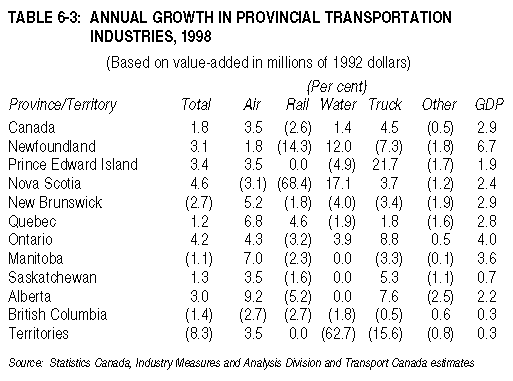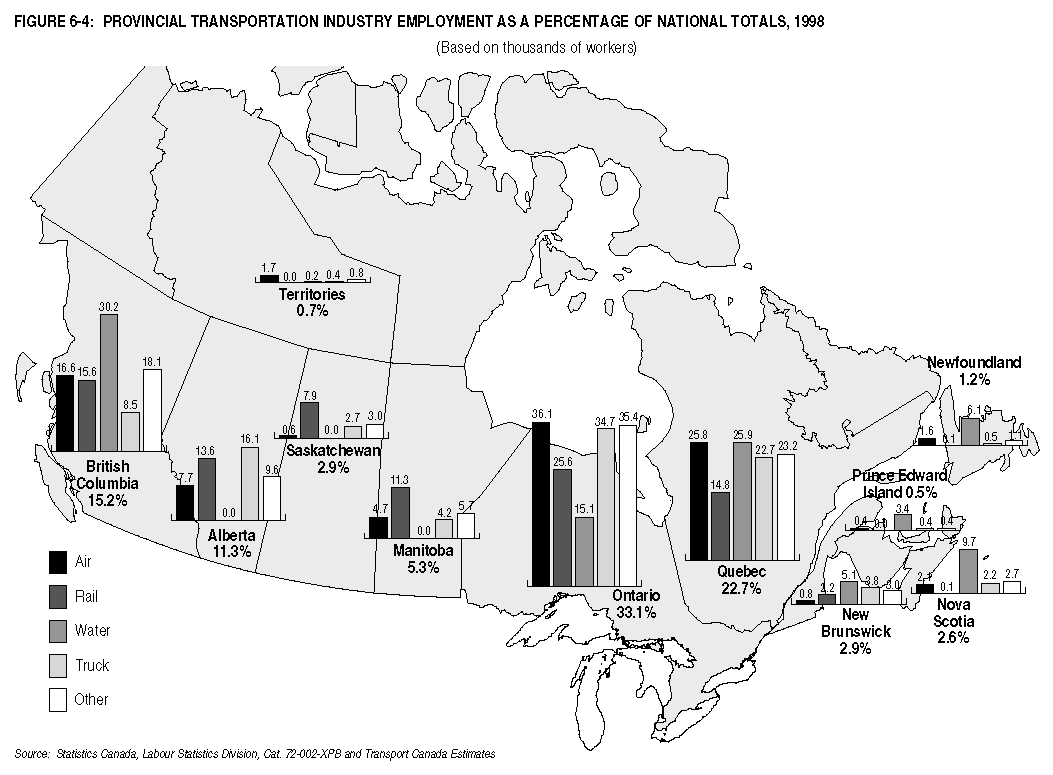6
TRANSPORTATION AND REGIONAL ECONOMIES
The Supply of Transportation
Structure of Provincial Economies
The importance of provincial transportation within the national
economy is related to the size and structure of the provincial
economies. Also important are the provinces' primary commodities
production and their specific geography. Figure 6-1 portrays the
size and structure of each provincial economy relative to the
national economy. Four provinces account for most of the economic
activity in Canada, with Ontario accounting for 41 per cent of
national gross domestic product (GDP), followed by Quebec at 21
per cent, and British Columbia and Alberta with 12 per cent each.
No other province accounts for more than four per cent of Canada's
GDP.

In terms of structure, Ontario's economy is dominated by the
manufacturing and construction sector (50 per cent) and a disproportionately
low share, along with Quebec, of primary commodity production.
At 42 per cent, Alberta is the greatest contributor to the primary
commodities sector.
In terms of economic growth, Ontario, followed by Quebec, was
the prime driver of national growth, largely because both provinces
showed strong growth in exporting manufactured goods to the United
States. Growth in Alberta was lower, because commodity prices
were lower, whereas in British Columbia growth was relatively
stagnant following the Asian crisis. Newfoundland posted the highest
growth of the small provinces, after the Hibernia project came
on line in 1998. Saskatchewan posted the lowest growth, as a result
of the Asian crisis and low commodity prices. Table 6-1 compares
the annual growth of the provincial economies in 1997/98.

In terms of national trade, Ontario predominates, particularly
for exports. As Figure 6-2 shows, only Ontario and Alberta among
the large provinces enjoyed trade surpluses in 1998, while only
Newfoundland among the smaller provinces enjoyed a trade surplus.
British Columbia faced a large trade deficit, which reflected
the weak demand for primary commodities in Asian markets.

Table 6-2 shows that Ontario outperformed all other provinces
and territories in terms of growth in 1998. Growth was slower
in Alberta and particularly in British Columbia. Among the
smaller provinces, Newfoundland posted high export growth, again
due to Hibernia. Exports grew less than imports in Quebec,
New Brunswick, Nova Scotia, and the Territories.

Provincial Transportation Industries
Figure 6-3 shows each province's transportation industries
as a percentage of the national totals. In terms of total transportation,
the top four provinces - Ontario, Quebec, British Columbia and
Alberta - are also the top provinces in terms of relative size
of their provincial economies. Ontario is the only province to
show a lower share of Canada's transport activities (33 per cent)
than that of total economic activities (41 per cent). This can
be explained by Ontario's proximity to its key markets (including
large US markets), by the low share of primary commodities
in its economy, and by its higher population density.

In contrast, British Columbia shows a higher share of total
transport activity. Its transport industries accounted for 16.4
per cent of the national total, while its provincial gross domestic
product (PGDP) stood at 12.3 per cent of the national GDP. Two
reasons for this include its location as a hub for transport to
Pacific Rim countries and its unique and challenging topography.
Both AlbertaNote
5 and Quebec exhibit shares similar to the size of
their respective economies. All the smaller provinces exhibit
transport shares higher than PGDP, particularly Manitoba and to
a lesser extent New Brunswick. Each of these provinces serves
as a base for western and eastern regional transport activities
to and from central Canada, respectively.
The figures for provincial trucking as a proportion of national
trucking reflect the distribution of total transportation industries.
Exceptions are British Columbia at 11.1 per cent, where the lower
share of trucking may reflect the mountainous terrain, and Alberta
at 16.1 per cent, where the higher share of trucking
may compensate for a lack of marine transport.
Ontario has the highest provincial share of national rail transportation,
followed by the western provinces and Quebec. Manitoba and Saskatchewan
have a slightly smaller share. This distribution reflects high
production of primary commodities (e.g. wheat and coal) in Western
Canada, a more dispersed population, and no direct marine access
in the Prairie provinces.
The distribution of marine transportation is driven not so
much by provincial economic importance as by access to water.
Consequently, British Columbia has the largest share of national
water transportation at 37 per cent, followed by Ontario, Quebec
and Nova Scotia, which reflects the location of major ports. As
expected, the island provinces of Newfoundland and Prince Edward
Island also exhibit relatively high shares of marine transportation.
Air transportation figures show that Ontario ranks highest
of all provinces. British Columbia slightly exceeds Quebec, and
Alberta ranks similarly to its provincial economy. British Columbia's
position is again explained by the difficult terrain, as well
as its function as a hub for Pacific Rim countries. In the smaller
provinces, the relatively higher share of air transportation in
Newfoundland and the territories results largely from their isolated
geography.
The amount of other transportation recorded in the provinces
is roughly related to their total economic activities. Different
policies towards public transit may be reflected in the slightly
higher percentages in Quebec and British Columbia, and a slightly
lower percentage in Alberta.
Provincial Growth in Transportation
Table 6-3 shows 1997/98 annual growth in provincial transportation
industries for the air, rail, marine, trucking and "other"
modes. Provincial growth in transportation industries was driven
primarily by Ontario, where economic growth was served largely
by trucking services. In the other larger provinces, transportation
growth was below economic growth. British Columbia, Manitoba and
New Brunswick each showed a net decline.

Trucking experienced strong growth due to exports, particularly
in Ontario (8.8 per cent) and Alberta (7.8 per cent).
In Prince Edward Island, trucking has grown rapidly since the
bridge linking the island and the mainland was completed. Trucking
declined in British Columbia, and the territories and Newfoundland
experienced large declines.
Driven by weak world commodity prices, rail transportation
registered declines in all provinces except Quebec.
Marine transportation showed negative growth in British Columbia
and Quebec, and positive growth in Ontario. High growth in both
Nova Scotia and Newfoundland resulted from increasing imports
through Nova Scotia and the Hibernia oil fields in Newfoundland.
Transportation of passengers by air was relatively strong,
particularly in Alberta and Quebec. Only British Columbia and
Nova Scotia registered declines. Other transportation activities
were either stagnant or declined in all provinces. Alberta showed
a particularly large drop, which possibly reflects a decrease
in the use of public transit.
Employment in Transportation Industries
The indicator for provincial employment in transportation industries
in 1998 produces much the same pattern as that provided by the
value-added indicators. Figure 6-4 shows that the four largest
provinces rank in order of economic size. Ontario exhibits a lower
percentage than might be expected from its provincial economy,
and British Columbia ranks slightly above the share of its PGDP.

The modal distribution also tracks the pattern of relative
shares using the value-added indicators with a few exceptions.
For instance a relatively higher employment figure shows up in
Quebec for certain modes (air, rail and water), and relatively
lower shares are apparent in Saskatchewan for rail and trucking.
Provincial Growth in Transportation Employment
Growth in transportation employment follows a similar pattern
to the growth of value-added for the transportation industries,
as shown in Table 6-4. Ontario led in growth with 2.6 per cent,
followed by Quebec and Alberta, while British Columbia posted
a decline. In the smaller provinces, transportation employment
growth was strong in Newfoundland and Prince Edward Island
but declined in Nova Scotia and Manitoba.

Specifically, growth in trucking employment was strong in Ontario
and Alberta, but declined in British Columbia. Rail employment
declined in all provinces except Quebec. Marine employment grew
strongly in Quebec and Ontario, did well in Newfoundland and Nova
Scotia, but declined in British Columbia, Prince Edward Island
and New Brunswick. Growth in air employment was strong in all
provinces except Alberta, British Columbia and Nova Scotia.
Other transport employment grew strongly in the territories,
but growth was low or declined in all the provinces.
The Supply of Transportation
- Transportation and Regional Economies Transport
Related Demand and Investment
Appendix 6-1a Transport-Related Expenditures
by Province as Percentages of National Totals, 1998
Appendix 6-1b Annual Growth in Transport-Related Expenditures
by Province in 1998
Appendix 6-2 Provincial Transport-Related
Investment as a Percentage of National Investment, 1997
|

